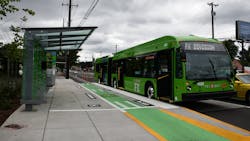TriMet’s FX bus service begins on a transformed Division Street Corridor
Distinctive bright green, articulated buses started carrying Portland, Ore., passengers along a 15-mile route for the first time on Sunday, Sept. 18. TriMet says the new public transit service, FX2-Division, not only connects downtown Portland to southeast and east Portland and Gresham but will provide greater access to educational and employment opportunities.
TriMet says the opening of the FX service marks the “transformation of the Division Street corridor and the new tier of bus service” delivered through the work of minority and women-owned certified businesses.
“In January 2020, TriMet, the FTA and our partners kicked off the Division Transit Project surrounded by colorful images reflecting the diversity, culture and vibrant spirit of the Division Street Corridor; we launched a campaign we called ‘A Division of Possibilities’ and never has a slogan become more fitting,” said TriMet General Manager Sam Desue Jr. “Not only has the Division Transit Project made a better, faster type of bus service possible, the project transformed a high-crash corridor, making it possible to safely walk, bike and drive along and across Division Street. Now, more possibilities lie ahead with the launch of TriMet FX™—Frequent Express.”
The FX2-Division route is the first of TriMet’s FX bus service and features all-door boarding, business access and transit lanes at key locations to improve the movement of buses, on-board bike racks and 60-foot articulated buses powered by renewable diesel. The new service embraced technology advancements such as electronic fare readers inside all three doors, self-operating technology allowing people with mobility devices to secure their device and next-generation transit signal priority to move buses along Division Street.
“Metro and our regional partners have dedicated countless hours to plan high-capacity bus service in the Division Corridor that works with, and for, the communities it serves,” said Metro Council President Lynn Peterson. “It’s great to see our efforts and all the feedback from the community, especially those that served on the Community Advisory Committee, hit the road with the opening of the first FX line.”
In addition to bus infrastructure, TriMet coordinated efforts with the city of Portland to deliver a safer Division Street. Improvements made as part of the Division Transit Project and the Outer Division Safety Project include protected intersections, nearly 81,000-square feet of new sidewalks, 11 new marked crosswalks, lighting upgrades, 4.5 miles of protected bike lanes and 10 additional signalized pedestrian crossings.
“The connected efforts between PBOT’s Outer Division Safety Project and TriMet’s Division Transit Project have transformed one of the most dangerous high crash corridors in the region into a welcoming, safe access point for all—no matter how you choose to travel,” said Portland Transportation Commissioner Jo Ann Hardesty. “Making it safer, faster and greener for people to move about their daily lives through a project that created living wage jobs enriches our entire region and public transit system.”
The $174.8 million project was funded through state, county and federal sources including an $87.4 million Capital Investment Grant from the Federal Transit Administration (FTA), as well as more than $24 million from TriMet.
“Today, we are celebrating another innovative project from TriMet—combining the capacity and reliability of the city bus with modern amenities that will mean a faster, cleaner, and smoother ride for people in Portland and Gresham,” said FTA Region 10 Administrator Linda Gehrke. “FTA was happy to support TriMet’s Division Transit Project with $87 million, providing federal support to a project that will improve safety, lessen Portland’s environmental footprint and help get people where they need to go faster and more efficiently.”
About the Author

Mischa Wanek-Libman
Group Editorial Director
Mischa Wanek-Libman is director of communications with Transdev North America. She has more than 20 years of experience working in the transportation industry covering construction projects, engineering challenges, transit and rail operations and best practices.
Wanek-Libman has held top editorial positions at freight rail and public transportation business-to-business publications including as editor-in-chief and editorial director of Mass Transit from 2018-2024. She has been recognized for editorial excellence through her individual work, as well as for collaborative content.
She is an active member of the American Public Transportation Association's Marketing and Communications Committee and served 14 years as a Board Observer on the National Railroad Construction and Maintenance Association (NRC) Board of Directors.
She is a graduate of Drake University in Des Moines, Iowa, where she earned a Bachelor of Arts degree in Journalism and Mass Communication.
